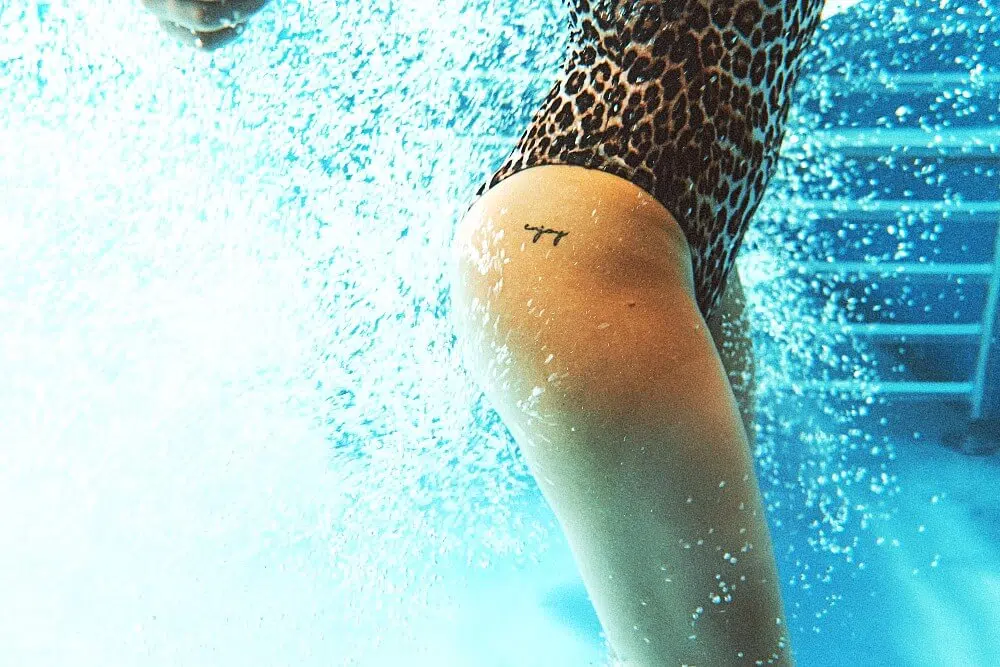What is aquajogging? It's simple, it consists of run in the water ! Immersed up to your neck, you do not touch the ground floating using an aquajogging belt.
It is an ideal practice to recover from an injury or to vary your training. Whether you are a runner or not at all, aquajogging allows you to tone your body all in improving your endurance.
Aquajogging, quesaco?
With aquajogging, you perform the same movements as running, but immersed in water. This is a water sport practiced in deep water since you must not touch the ground.
It's a gentle alternative to running which allows you not to suffer the impact when you put your foot down. There is therefore no no shock to your joints.
Aquajogging can be practiced with a coach, or alone. In a swimming pool, in a lake or at the sea (it's a little more complicated), you have the choice!
The principle of aquajogging
The goal is to succeed in break down your stride to be able to do it in the water. You can perform the movements in this way:
- Static to tone the lower body.
- Dynamic, on the go, to improve your cardio.
You must remain straight and strong so as not to lean forward. You will then strain your abdominal muscles as well as your trunk muscles.
When you take your strides, don't raise your knees too high, try instead to make a movement back and forth. Adopt a normal stride.
An ideal practice in addition to running
Combining running and aquajogging is very interesting for increase training volume without risking injury. Start by getting your body used to aquajogging with fairly short sessions.
Once you feel comfortable, you can increase the length and pace of the sessions. Alternate between running and aquajogging to vary the workouts !
It is a very interesting practice for:
- To recover after one competition or a big session.
- Recovering from an injury while remaining active.
- To train for improve your running form and have a good movement.
How does an aquajogging session take place?
It all depends on your goal, but sessions generally last between 30 to 45 minutes. The efforts made during an aquajogging session are more tiring than running, so start slowly!
No matter what, you always start with you warm up during about 10 minutes : knee climbs, heels-buttocks, a few lengths of swimming pools, etc.
Then you move on to the heart of the training which can be done in three different ways.
Three types of workouts
1. Constant pace training
You make the movements for several minutes with the same rhythm and without pause.
This type of training will allow you to work on endurance, over the sessions the duration of the effort becomes longer.
2. Interval training
You alternate between work time and recovery time. For example, 30 seconds at high intensity, then 30 seconds of rest.
Working hours gradually increase, 30 seconds, then 45 seconds, then 1 minute, etc.
By making several blocks, you will be able to work in intensity.
3. Training with variation of pace
You mix fast, medium and slow pace. The session then becomes varied and uses your muscles differently.
By carrying out this type of aquajogging session, you will concentrate on the muscle development.
Equipment used during an aquajogging class
The essential equipment for aquajogging is none other than the flotation belt. It will keep you at the right height so that only your head and neck protrude above the water.
Of the foam dumbbells are sometimes used to allow floating while adding a little resistance during the movement.
How to do aquajogging alone?
As for an aquajogging session with a coach, always start by warming up. To keep a good rhythm and motivate yourself, take out your speaker and put on some music!
Get into position
Put on your flotation belt and jump into the water. Once in the water, stand up straight and stay strong. Avoid leaning too far forward.
Keep your arms alongside your body, ready to be on the move.
The aquajogging movement
Once you are in the correct position, legs straight, come raise your knee a little then unroll it forward. When you straighten your leg, come and scratch the water with your foot while straightening your ankle.
Do not fully extend your leg, keep a small angle so that your leg is bent. Your foot must be dynamic and active, a bit like the brush of a paintbrush going back and forth.
Repeat the movement slowly until you are comfortable. Then you can add a little more speed and rhythm.
The position of your arms
They must be moving, like when you run. Don't try to use them to stay on the surface, your belt takes care of it. They are there to balance you during your movement.
keep them shoulders and the arms relaxed so as not to tire yourself too quickly.
Then all you have to do is choose the workout you want : constant pace, split or variation of pace. Start with short sessions and increase gradually.
Some tips for aquajogging like a pro
For a good aquajogging session, here are some tips that will be useful to you:
- Always stay relaxed. in your movements.
- Think of breathe well during exercise.
- Contract your abs to be sheathed.
- Take a bottle of water or a gourd for you moisturize.
- Imagine yourself running outside.
Our little tips for successful movement
And to learn the movement well and perform it in the best way, try this:
- Start with straight legs, a bit like the scratched on the ground.
- Push leg forward and back.
- Don't just move your knees up and down.
- Gradually unwind your stride by breaking it down.
- The heel helps bring the leg back to complete the gesture.
What are the benefits of aquajogging?
There are many of them, it's a bit like combining the benefits of running with the benefits of water.
- The movements are without shock to your joints.
- Aqua jogging tones and strengthens the whole body slowly.
- You strengthen your abdominal strap thanks to the constant sheathing.
- This sport allows you improve endurance and cardio.
- Water pressure promotes blood circulation.
- You burn more calories than running.
- The massaging effect of water helps you reduce cellulite.
- Without impacts, this sport promotes recovery.
- Aquajogging allows you improve your proprioception.
- You develop a better flexibility.
- YOU strengthen your hip flexors (often weak).
- This sport also helps you improve your running posture.
- There water temperature allows your body to regulate your heart rate.
You will have understood, aquajogging is full of benefits, but what is even better is that it is accessible to everyone.
Who is aquajogging for?
This activity is accessible to everyone. Since water prevents you from feeling any shock, aquajogging is ideal for people who have fairly fragile joints.
It is a sport that is very recommended for runners in order to:
- Recovering from an injury by continuing a gentle sporting activity.
- Practice a complementary sport next to running.
- Strengthen underused muscles during the running.
- Increase training volume without risking injury.
Of course this also applies to those who do other sports! Aquajogging is ideal as a complementary activity and deserves to be known. However, it is sometimes confused with aquarunning.
Aquajogging and aquarunning, what are the differences?
It's simple, with aquarunning YOU run on a treadmill submerged in water. While with aqua jogging you realize the running movements while floating in water using a flotation belt.
When you make L'aquarunning, you are partially submerged, usually up to the waist. THE treadmill is slightly inclined and has no no engine. You make it work with the strength of your legs while running.
These are two water sports that are similar, because you run in the water, but they still remain quite different. If you would like to know more about aquarunning, come take a look at our article!
What if you discovered other water sports?
It's not just aquajogging that is practiced in water, many other practices exist (aquabike, aquagym, etc.).
For the most curious among you, we invite you to visit our article dealing with different water sports.
And besides, at Aqua by we invite you to discover aquabike with group lessons mixing sport and pleasure. So, if you want to pedal in the water in a good mood, take the plunge !
come join us in one of our studios located in Paris or Boulogne, we are waiting for you!



